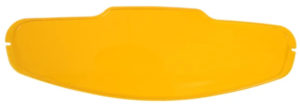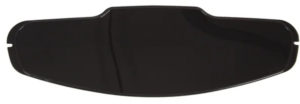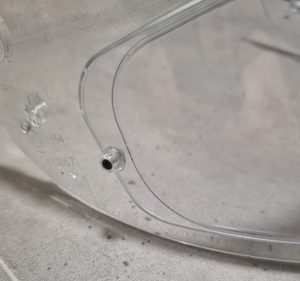Visor fogging is an issue in most climates. Your breath is significantly warmer than the air on the other side of your helmet’s visor and turns to condensation on contact with its cool surface.
Pinlock is a visor system with interchangeable lenses that tackles this problem,it has established market dominance to the point that most mid to high-end helmets are either Pinlock compatible or ship with a Pinlock system already installed.
Save Money On Your Motorcycle Insurance
- You could pay less than £195*
- Compare quotes from 25+ UK providers
- Fill in one form to compare top bike insurers
How Does a Pinlock System Work?

Pinlock is a visor system with interchangeable lenses that prevents condensation forming by insulating the visor and also absorbing any moisture that forms.
Insulation
The Pinlock insert (which is a separate piece to the Pinlock visor) has a raised bead of silicone around its outer edge.
When installed, this silicone creates an airtight seal, leaving a tiny air gap between the visor and insert.
This gap acts as an insulator, meaning the surface your breath comes into contact with is significantly warmer than the outer visor.
If a large temperature difference is not present, fog is much slower to form and quicker to dissipate.
Moisture Absorption
Pinlock lenses are also made of moisture-absorbing material, meaning even when the temperature difference is significant enough to cause fogging, the lens will absorb the excess moisture.
How much moisture your lens can absorb depends on which of the three available types you buy.
The 30 series is designed for casual use, the 70 series for regular use, and the 120 series for intensive use.
In our experience, the 30 or 70 series is sufficient for most commuters, and the 120 series suited to more demanding riding like track or motocross.
Installation And Adjustment
As the name suggests, the Pinlock system depends on two pins, placed on the inside of your visor at about the midpoint. Slots on either side of the lens insert match up with these pins.
Note: each helmet manufacturer uses a different type of insert, you will need to buy the correct one for your helmet
You can find a large selection on SportsBikeShop.
To install a Pinlock insert:
- Remove your visor from your helmet
- Brace one end of the visor with your elbow and side/love handles
- Gently straighten the curve of the visor slightly until you can slot both notches on the insert into the pins on the visor (careful to avoid leaving fingerprints on any of the surfaces here)
- Allow the tension of the visor to return to normal and the insert should make an airtight seal and place the absorbent material across the critical part of your field of vision
- If the seal is imperfect, adjust the tension of the insert by turning the pins (or screws inside those pins – depending on the type)
Gotchas
A common confusion with people who have never used a pinlock is that they come with a yellow film on the back of them and people often fit them as they are, without peeling the film off.
This not only means you have a yellow tint to your visor but the pinlock doesn’t work.
The film is only there to protect the pinlock insert from scratches so peel the film off and you are good to go.
Pin Types
Three pin types are available, ascending in functionality, adjustability, and cost: push pin, three-component pin, and tear-off pin.
- Push pin: The most common on commuter, touring, and road helmets, offering medium tension with a decent level of tension adjustment by turning with thumb and finger.
- Three-component pin: Comes with an integrated screw for finer adjustment and a higher level of grip and tension.
- Tear-off pin: Compatible with tear-off strips used by track and motocross riders. and otherwise similarly built to the three-pin type Pinlock, using a screw for extra tension and fine control.
Field Of View
Pinlock’s latest series of Max Vision inserts are being supported by a growing number of premium manufacturers, offering a significantly wider field of view than the standard system.
For us, and most riders, the original system is more than sufficient.
The peripheral vision gained by using the Max Vision inserts could be of benefit to intense riding situations on the track or trail but isn’t strictly necessary for commuting.
Alternatives/Competitors
From what we’ve seen and heard, other manufacturers’ attempts at a similar system seem like inferior knock-offs.
There are some chemical spray solutions that can be applied to the inside of your visor to prevent or at least reduce fogging. These work but need to be reapplied regularly and don’t offer the same kind of fit-and-forget solution as the Pinlock system.
Read this for some other ideas for keeping your helmet visor clear from fog and rain.
Drawbacks
Distortion
Using the Pinlock system adds another layer of material for you to look through. This inevitably causes minor distortion. Some people experience this worse than others and report that low light conditions make this a bigger problem.
Most people (us included) can barely notice it’s installed.
Installation and Fitting
Fitting a pinlock insert can be a bit tricky, and you need to get it right otherwise it won’t work.
Before you even begin to fit your insert, you need to remove your visor, if you are unsure how to do this, be sure to check online with the manufacturer’s website.
Arai helmets are notoriously tricky for both taking off and putting the visor back on.
The insert needs to be tight between the two pins, which you can usually twist a little to secure the insert.
Lastly, pinlocks are made for different helmet brands, so they are not universal, you will need to buy one that will fit your helmet specifically. You can find a large selection on SportsBikeShop.
Cleaning
When your pinlock starts to mist up, it may need cleaning, so remove it carefully, rinse under cold water, leave to air dry, then wipe away any dust with a clean microfibre cloth.
If regularly installed and uninstalled, some people report difficulty in getting the right tension on their insert or problems with the silicone bead degrading.
This can lead to fogging even with the insert installed. Buying the three-component pin version will help extend the life of these parts.
Wear and Tear
Eventually, a pinlock will wear out and need replacing. Pinlocks can cost as much as a new replacement visor but they are well worth the money.


